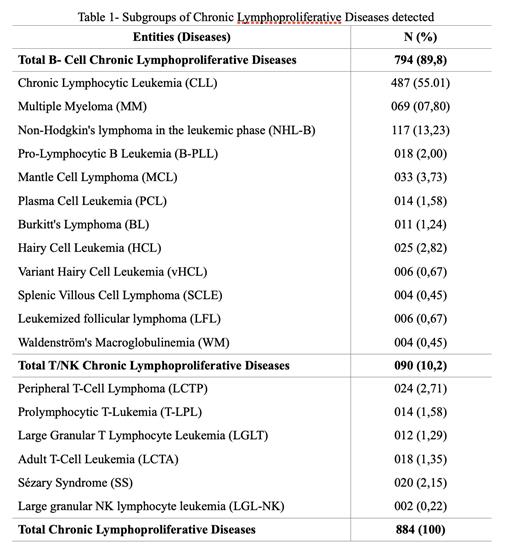INTRODUCTION: Chronic lymphoproliferative diseases (CLPD) are considered as a heterogeneous group of diseases characterized by monoclonal expansion and accumulation of apparently mature lymphocytes, which have a proliferative and/or survival advantage over normal lymphocytes in different organs such as bone marrow, peripheral blood and lymph nodes. This translates into the progressive accumulation of clonal cells and their products, causing peripheral blood and bone marrow lymphocytosis, in addition to lymphadenopathy, splenomegaly or other organomegaly. According to the World Health Organization, which reflects the international consensus and is based on pathological, genetic and clinical factors, lymphoproliferative neoplasms are classified according to the stage of maturation and the lineage where the neoplastic transformation occurs through flow cytometry (FC). OBJECTIVES: The aim of this study was to demonstrate the immunophenotypic diagnostic profiles of patients with CLPD in Rio Grande do Norte, Brazil by FC. METHODOLOGY: Were investigated 884 patients with CLPD of both sexes through CF with a panel of monoclonal antibodies directed to CLPD. In addition, other patient information, such as age, gender, and clinical and hematological data were also collected. RESULTS: The results showed that 89.7% of the cases were B Cell CLPD (B-CLPD) and 10.3% T and natural killer cells (T/NK-CLPD). The distribution of B-CLPD cases were as follows: 487 Chronic lymphocytic leukemia; 18 B-Cell Pro-lymphocytic leukemia; 25 Hairy cell leukemia; 6 variant Hairy cell leukemia; 6 Follicular lymphoma leukemized; 4 Splenic lymphoma with villous lymphocytes; 33 Mantle cell lymphoma; 4 Waldenstrom's macroglobulinemia; 69 Multiple myeloma; 14 Plasma cell leukemia; 11 Burkitt's lymphoma and 117 Leukemic Non-Hodgkin lymphoma (Table 1). The distribution of CLPD-T/NK was as follows: 12 Large granular lymphocytic leukemia; 14 T-Cell prolymphocytic leukemia; 18 Adult T-cell leukemia; 20 Sézary syndrome; and 24 Peripheral T-Cell lymphoma and 2 DLPC-NK (Table 1). DISCUSSION: The B-CLPD are the most commonly observed corresponding to more than 85% of all cases and are characterized by the presence of clonal B lymphocytes with expression of a single type of immunoglobulin light chain (kappa or lambda) in a proportion greater than 1/10, associated the strong positivity of Pam-B antigens such as CD19, CD22 and CD20 and the absence or low expression of Pam-T antigens. However, other antigens such as CD200, CD5, FMC7, CD79b and CD103, among others, may be present or absent, specifically characterizing these entities as Chronic lymphocytic leukemia (weak CD22+; CD200+, CD5+, FMC7-, CD79b-), Hairy cells leukemia (strong CD22+; FMC7+; CD79b+; CD5-; CD200-; CD103+; CD123+; CD11c+ and Follicular lymphoma (strongCD22+/CD20+, CD10+, CD200-, CD79B+, FMC7+). T/NK-CLPD are less frequent and are characterized by the expression of Pan-T antigens CD2, CD3, CD5, CD7, CD28 and TCL-1, with clonality evidenced by strong positivity of TCRα/β in most cases and increase of TCD4+ or TCD8+ lymphocytes in a ratio above 1:10 in most cases. In this group, large granular lymphocyte leukemia (LGLG) is a rare type of T/NK cell CLPD characterized by peripheral and medullary infiltration of large hypergranular lymphocytic cells, comprising about 2-5% of all cases, the most commonly seen being CD8+ T cells. CONCLUSION: The results presented demonstrate that immunophenotyping is a defining technique for clarifying the diagnosis of patients with CPLD, clonality was also successfully characterized in the investigated cases of CPLP of B ,T and NK lineages.
Disclosures
No relevant conflicts of interest to declare.


This feature is available to Subscribers Only
Sign In or Create an Account Close Modal